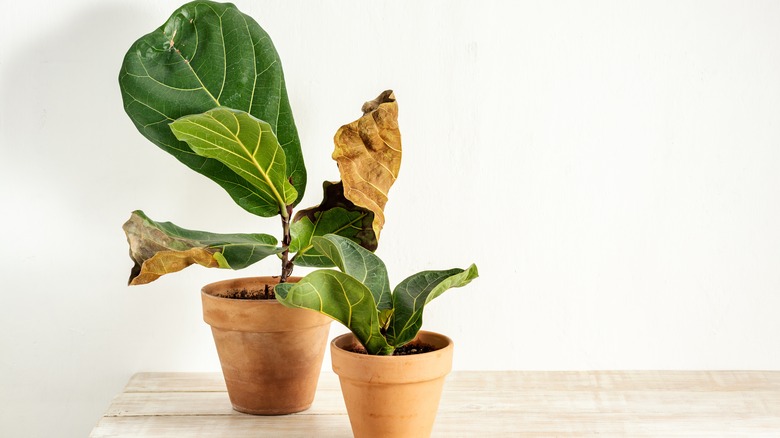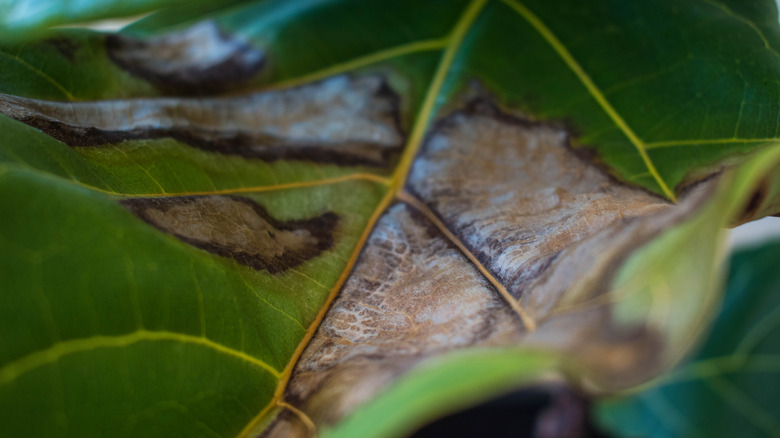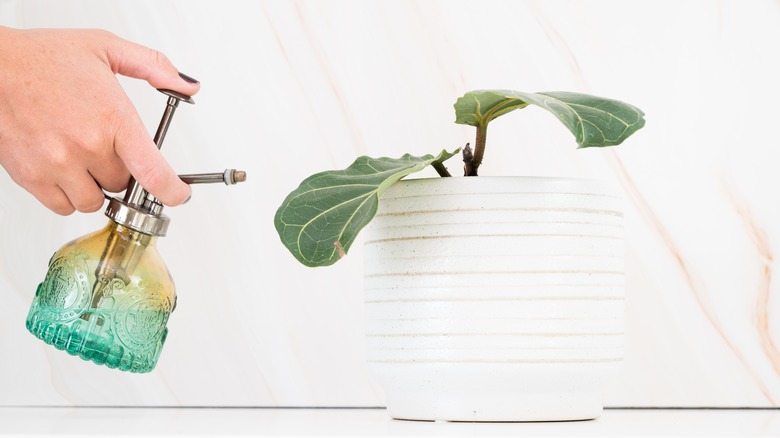It May Not Be Too Late To Bring Your Dried Out Fiddle Leaf Fig Back To Life, Here's How
While fiddle leaf figs are notoriously finicky plants, as long as you understand their needs and provide them with the right growing conditions, they are great and easy indoor plants to care for. That said, if you forgot to water your fiddle leaf fig or the humidity levels in your home aren't in a range that the tropical plant thrives under, it will let you know when its leaves brown, curl, and drop altogether.
Fiddle leaf figs are native to tropical rainforests where the humidity levels are anywhere from 75-95%, and as such, thrive best in very humid environments. Though this is not a realistic (or a recommended) humidity level to keep your house at, figs are well adapted to grow in an indoor setting that maintains a humidity level of at least 40%.
Though there are several reasons your fiddle leaf fig plant can look unhealthy, if your plant has leaves with brown spots that start at the edges instead of the middle, this is likely caused by dryness. While brown, curled leaves concentrated at the bottom of your fiddle leaf fig would indicate a problem more closely aligned with overwatering, such as root rot, dead-looking leaves throughout the entirety of the plant are a good indication that your plant is dehydrated. Fortunately, even if your fiddle leaf fig is dry enough to be at death's doorstep, it may not be too late to revive it.
Salvaging your dry fiddle leaf fig
The first step to bring your fiddle leaf fig back from the brink of death is assessing just how close to the brink it actually is. If it's just beginning to look sad and dehydrated, don't panic — just keep an eye on it and water more frequently and thoroughly. Using a moisture meter can be a useful tool in helping gauge just how dry your fiddle leaf fig's soil is and can also help guarantee your plant is getting enough water.
If your fiddle leaf fig's leaves have begun to brown and curl due to dehydration, remove each one that has damage to more than half of it. Leaves that have completely dried out or have almost done so will not come back, so removing ones that look dead allows your fig to focus its energy on repairing damage to its healthy parts while encouraging new growth. Though your fig will eventually drop dead leaves on its own, removing them by hand can help speed up the regeneration process and give your plant a better chance at survival.
Even if you have to remove the bulk of your plant's leaves, as long as its trunk shows signs of life, there's hope for your plant to make a comeback. If the trunk and branches feel dry and brittle as opposed to supple and soft, there's a good chance your plant is unable to be saved.
Assessing why your fiddle leaf fig is dry
If you are certain that you're watering your plant as frequently and thoroughly as you should be, but you still notice that the soil is dry and the leaves are looking crispy, there are other possible causes. Because fiddle leaf figs are extremely reactive to changes in climate, your plant may get drier during summer months, not only because the temps are hotter overall, but because you probably have the air conditioning running. The use of AC can dry out the air in your house and create an inhospitable environment for your fig by depriving it of the humidity it needs. So make sure your fiddle leaf fig is not anywhere near a floor or ceiling vent where it would be directly exposed to an influx of dry air.
If you aren't underwatering your fiddle leaf fig, and you've ensured that it's not near a vent, double-check the type of pot it's planted in. If it's in a nursery pot, that may be the reason for your dry plant. Nursery pots are specifically designed to keep a plant's roots dry so it can tolerate being watered every day in a greenhouse setting. But keeping your fiddle leaf fig in one of these for too long can prevent your plant from maintaining adequate moisture levels. If your fig is dried out and has been in a nursery pot for longer than one month, try switching it to a different pot.
Preventing your fiddle leaf fig from losing moisture
If your fiddle leaf fig is dropping leaves, that's a good indication it's having a hard time maintaining adequate hydration within the environment. As a general rule of thumb, your fig will need to be thoroughly watered when the top inch of the soil begins to feel dry, which is usually about once a week. When watering your fig plant, don't stop until water freely flows from the holes in the bottom of the pot, which ensures that the soil is well draining. If you aren't saturating your fig plant each time you water it or you are letting it completely dry out between waterings, you'll run the risk of your plant drying out.
In addition to properly watering your fig plant, you will also need to maintain a humid growing environment in order to prevent it from becoming dehydrated. To prevent your plant from losing moisture, mimic the humid conditions of its natural habitat by misting it once a day. Ensuring the temperature stays consistently between 65 to 75 degrees Fahrenheit can also help limit the rate of water loss while working to speed up the revival of any dehydrated leaves. Running a humidifier in the room can also help keep the humidity level of its environment at a suitable level. Keeping your plant in a room like a bathroom or basement that stays consistently humid is also a good way to guarantee the plant doesn't lose moisture.


